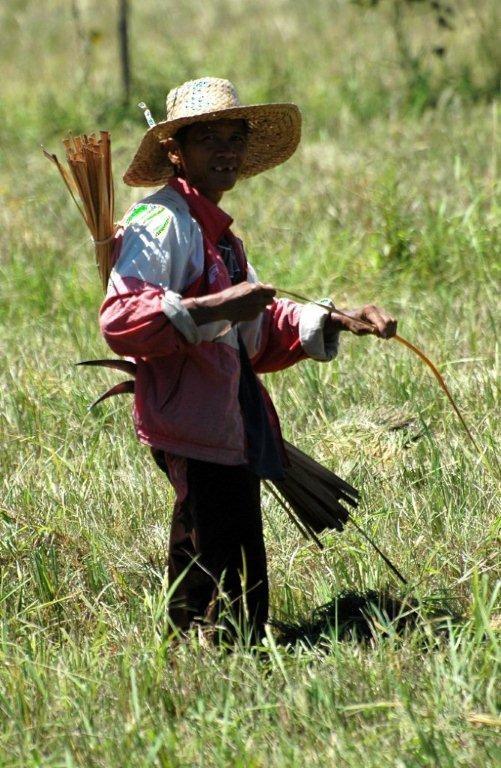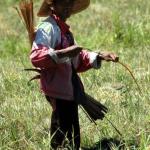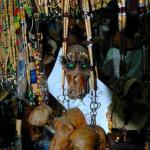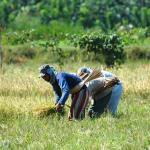The last tribes of Mindanao, the Bagobo, the New People.
Scattered throughout the Southern Philippine Archipelago slowly disappearing tribes untouched by neither time nor colonization still exist in present time. Along the desolate eastern coast of the Davao Gulf, centuries ago, new migrants mixed with the native population, forming a new community that was given the name Bagobo. This tribe traces its origin from the people who brought Hinduism to Mindanao, its name was derived from the words bago meaning new and obo meaning growth. Throughout centuries a strong social structure has enabled these native groups to blend well with the original population, retaining their indigenous customs, beliefs and values.
The mountainous region between the upper Pulangi and Davao rivers is the homeland of the Upland Bagobo, the coastal Bagobo once lived in the hills south and east of Mount Apo, where according a legend, their supreme god and common ancestor Apo Sandawa ruled as God. Mount Apo is the Bogobo ancestral domain and their sacred place of worship.
Sibulan is an ancient settlement of the Bagobo, located at the foot of a dormant volcano Cuernos de Negros, meaning the Horns of Negros but also known to the natives as Magaso.Sibulan was the center of all the Bagobo tribes when the Spaniards try to conquer the island of Mindanao at the end of the nineteenth century. The Spaniards gave this region its name; the Land of Sibuls or land of numerous springs. Long time ago a group of Spanish soldiers met a group Bagobo women carrying bamboo tubes, tools they used to fetch water from the many springs in the area. None of the women understood the soldiers when they were asked what the name of the place was. The women thought the Spaniards were asking them for the source of the water, so they replied, Sibuls, meaning spring.
The Bagobo are by origin a nomadic tribe, they travelled from one place to the other by hacking their way through the virgin forests. The region was abundant with cogonal land with tall trees and had a wide area of hunting grounds. The bow and arrow were used both in hunting wild boar, deer or monkeys and fishing in crystal pure waters gushing from the slopes of Mount Apo. Apo means grandfather of all mountains and is the highest mountain peak in the Philippines. The land was also cultivated with various crops, but left behind after harvest time in search of a better place to cultivate.
The inhabitants in the early settlements feared the Anitos, spirits, which include deceased ancestors and nature-spirits or diwatas, who could grant their desire through offering of sacrifices. Their religion is an array of innumerable gimokods (spirits) who have to be shown respect. The Bagobo also believe in a supreme being who inhabits the sky world, as well as a deity, a supernatural immortal being who will brings sickness and death to incestuous couples. The principal Spirit is the great creator named Eugpamolak Manobo or Manama.
The knowledge of spirits and ancient legends resides in old tribal women, better known as mabalian, often they tell story of Tuwaang, a brave and strong warrior with different powers. One legend recalls the fight between Tuwaang and a giant from the land of Pinanggayungan. A maiden of the Buhong Sky who was fleeing from the giant of Pangumanon came across Tuwaang who was riding the sky on lighting. Tuwaang and the giant fought for the maiden, the giant used his magical powers and threw a flaming bar at Tuwaang. He was able to escape this ordeal by using his own magical ability and call the wind to fan the fire and let the giant be engulfed by his own flames.
The mabalian are also the ritual practitioners which include healing, they are also skilled as weavers.The women weave abaca cloths with earthly tones, heavily embroidering it with beads and stitch work. They are known for their inlaid metal betel boxes, finished with bells and baskets that are trimmed with multi-colored beads, fibers and horses hair. The never ending jingling of the many tiny brass bells woven into the clothing became a Bagobo symbol. It is not rare that the heavily ornamented Bagobo are considered the most colourful people of the Philippines.
Some Bagobo people have abandoned their tribal roots and embraced modern life, but most of the tribe's members remain proud of their heritage, traditions and their native cultural identity. They still wear their colorful costumes and play their ritual music with gongs and kulintangs, they dance their indigenous dances, stomping their feet on the ground and sing their harvest rituals in solemn chants. They will pass on their skills and knowledge to preserve their living, ethnic culture, a culure that is built to endure throughout generations to come.
 ThingsAsian
ThingsAsian




















